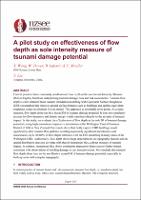A pilot study on effectiveness of flow depth as sole intensity measure of tsunami damage potential

Download
Date
2020-04-22Authors
Wang, Xiaoming
Power, William
Lukovic, Biljana
Mueller, Christof
Liu, Yaoru
Metadata
Show full item recordAbstract
Current practices have commonly used tsunami flow depth as the sole hazard Intensity Measure (IM) in fragility functions underpinning tsunami damage, loss and risk assessments. Tsunami flow depth is often obtained from tsunami inundation modelling with Equivalent Surface Roughness (ESR) assumption that removes ground surface features such as buildings and applies equivalent roughness values in a bottom friction model. This approach is potentially error-prone. As a static measure, flow depth alone can be a biased IM of tsunami damage potential. It does not completely account for flow dynamics and kinetic energy which contribute directly to the severity of tsunami impact. In this study, we evaluate the effectiveness of flow depth as the sole IM of tsunami damage potentials, using high-resolution comparative simulations at the Wellington Central Business District (CBD) in New Zealand. Our results show that firstly explicit CBD buildings would significantly alter tsunami flow patterns, resulting in possibly significant uncertainties and inaccuracies, up to 40-60%, in flow depth estimates with the ESR modelling in many areas of the Wellington CBD. Additionally, flow depth shows large dependencies on topography features and its spatial distribution does not correlate with that of momentum flux, a direct measure of tsunami impact. In contrast, momentum flux shows continuous attenuation from coast to further inland, consistent with observations of building damage in past tsunami events. We conclude that tsunami flow depth alone may not be an effective hazard IM of tsunami damage potential, especially in built-up areas with complex topography.
